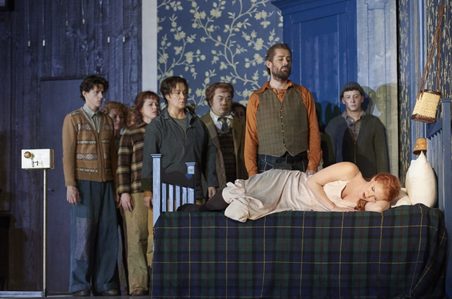 A scene from the COC's Ariodante. (Note heart-monitor on left.) Photo: Michael Cooper.
A scene from the COC's Ariodante. (Note heart-monitor on left.) Photo: Michael Cooper. The two leading sopranos – Jane Archibald as Ginevra and Ambur Braid as Dalinda – are young Canadians with pure yet strong voices and flexible coloratura delivery. Both have extended ranges, and can reach up into the stratosphere with thrilling results.
Archibald’s role is the larger of the two: she’s the main love interest, betrothed, and later married, to Ariodante, but pursued by the evil Polinesso. Her character calls for a wide dramatic range – from joy to despair – and she delivers it all. Her extended Act II aria was a tour-de-force of vocal technique and emotional intensity. Braid’s performance runs the gamut from love-sick to guilt-ridden. (She helps Polinesso enact his vengeful scheme, and then feels really bad about it.) There’s a sweet, slightly fluttery quality in her voice that makes her a pleasure to listen to.
There are two other women in the cast, playing men. In Handel’s day, the role of Ariodante was sung by a castrato – but as they’re hard to find nowadays, mezzo Alice Coote was engaged for the part. Vocally, she brings weight and an emphatic style of declamation to the title role. Mezzo Varduhl Abrahamyan doesn’t have the prettiest voice on stage – but her portrayal of the villainous Polinesso calls for no such thing. Her swaggering, man-spreading masculinity is a well-done caricature – and vocally, she could be a contender for the “Roulade of the Year Award” (if there were such a thing).
As for the men portraying men, there were rock-solid performances from tenors Owen McCausland as Lurcanio and Aaron Sheppard as Odoardo, and also baritone Johannes Weisser as the King of Scotland.
Scotland? I haven’t said anything yet about the setting of this opera, because that’s not really what this opera is about. Yes, Handel placed the opera in a vaguely Arthurian Scotland. And yes, director Richard Jones has retained a Scottish setting for the piece, updating it to the 1960s. But aside from Weisser’s kilt and touch of country dancing there’s little here to evoke Scotland as a real place. What comes across much more strongly is the “staginess” of the production: the stylized movement of the performers, and the inclusion of some brilliant puppet scenes in the opera. The dream-sequence where Ginevra becomes a pole-dancing stripper was especially imaginative.
Ariodante is not without its flaws. The strange doorknob-on-a-stick mechanisms looked silly – evoking some kind heart-monitoring machine you might expect to find in a hospital, rather than a simple door. (I kept waiting for a cast member to accidentally walk through a “closed” door, but I can’t say it ever happened.) Also, there were too many awkward on-stage costume changes. But overall, Jones’ approach worked: Ariodante isn’t really Scottish, and there’s nothing “realistic” about it, either. It is a theatre-piece, and underscoring its theatricality celebrated its essence.
Adding to the success of the production, COC music director Johannes Debus effectively scaled the COC Orchestra down to a baroque-sized ensemble. The COC isn’t Opera Atelier (Toronto’s “period” opera company), nor should it be – but in Ariodante, Debus & Co. showed an admirable attention to period style.
Finally, I can’t help noticing that both of the COC’s fall productions, Norma and Ariodante, have two things in common. First, are both co-productions, involving various North American and European opera companies. Second, they both made use of one set-piece for every act. While such ways of doing things can sometimes have “economic compromise” written all over them in large letters, on these occasions no compromises were evident. I hope, though, that the COC hasn’t decided that set-changes between acts are a thing of the past.
© Colin Eatock 2016
 RSS Feed
RSS Feed

